The pioneer of polemic taxidermy, or building imaginary monsters as a satirical apologetic device
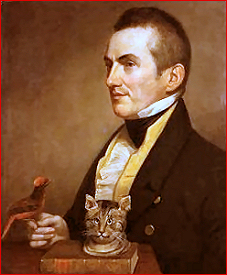 Charles Waterton is one of the great eccentrics of English history (and let's be honest: that's a long story really full of peculiar characters).
Charles Waterton is one of the great eccentrics of English history (and let's be honest: that's a long story really full of peculiar characters).Waterton was born at Walton Hall, in West Yorkshire, on June 3, 1782. He died at that same estate on May 27, 1865. In between, he traveled the world and made quite a name for himself.
His religion
If Waterton were looking over my shoulder right now, he himself would demand that any biographical sketch about him begin with the fact that he was Roman Catholic. He was an ardent and very proud Catholic. His ancestry, he claimed, included seven full-on Roman Catholic saints, ranging from Vladimir the Great to Sir Thomas More. British Roman Catholic author Graham Greene said, "Roman Catholicism has always been a great breeder of eccentrics in England. One cannot picture a man like Charles Waterton belonging to any other faith."
During his youth, Waterton's family was burdened by financial difficulties, which he blamed on the political policies of the Hanoverian Protestants. He grew up with a deep contempt for Protestants and Protestantism, and he practically wore his disrespect on his sleeve. He would attend meetings of the Protestant Reformation Society and heckle speakers whenever they used words like "Popery," or "Romanism."
His wit and his work
Charles Waterton was nonetheless a likeable man with a lively sense of humor and a roguish wit.
In fact, while Waterton was always a "good Catholic," he was not always a well-behaved one. In 1817, at age 35 (an age when lesser men have already begun to lose their youthful mischievousness) Waterton visited the Vatican. Touring the dome of St. Peter's, he climbed to an almost inaccessible lightning-rod on the roof and placed one of his gloves on top of it, like a flag. This caught the attention of no less than Pope Pius VII, who was not amused and demanded that the glove be removed. Waterton obliged, making the difficult climb for the second time in two days.
Climbing was one of Charles's passions. He was a prodigious climber, who could scale almost any wall, tree, or rock face. It is said that even at age 80, he still thought nothing of shinnying up a tree to examine a bird's nest.
This ability went well with his career. Waterton was a naturalist.
His career
In 1804, at age 22, Charles Waterton went to Guyana, where he oversaw the large estate of an uncle. This was a perfect life for an early nineteenth-century naturalist who wanted to make a mark in that field of study. He was the first to bring a usable sample of the poison curare back to England for study. He was a contemporary, acquaintance, and sometimes mentor to Charles Darwin (though he reportedly had little respect for Darwin's work). Many species of birds and other creatures in the West Indies were discovered and first described by Charles Waterton.
Near the end of his life, Waterton built a nine-foot wall around the family estate, effectively creating the world's first wildlife preserve. He also fought one of the first successful conservation campaigns—a long legal battle he waged and finally won against a soap manufacturer who was allowing chemicals to run downstream onto Waterton's property. Many of his ideas, which seemed as bizarre as his ultra-short haircut in his own time, are now (like the haircut) accepted as mainstream.
But there's still no denying that the man's eccentricity ran deep. It wasn't merely that he wore a buzz cut in an era when long hair was considered an essential part of good grooming; he also was known for bizarre antics like biting guests on the leg under the table like a dog. He also was flexible enough to scratch behind his ear with his big toe, and he loved to demonstrate that ability. And he deliberately bled himself copiously and regularly, believing this was how the body healed itself. He referred to the practice as "tapping one's claret."
His marriage
Understandably, Waterton remained unmarried until age 48, when he was wed to a girl 31 years his junior. She was an orphan with whom he had become infatuated in her infancy. He waited till she was old enough to marry, and by all accounts, their brief marriage was a happy one, but she died a year later from complications related to the birth of their son.
Charles was burdened with guilt related to his wife's death, and from that time on, he used a wooden block as a pillow, apparently as a form of penance.
His taxidermy
He practiced taxidermy as an extension of his work as a naturalist, and the skill he developed was remarkable. He pioneered the use of mercuric chloride to make the animal-skin hard and ward off harmful insects. Unlike other taxidermists, who stuffed specimens to fill them out after dissection, Waterton developed a process of shaping and hardening the animal skin, so that many of his finished works were hollow. This was a time-consuming process, but it enabled Waterton to mix taxidermy and high art. He found he could manipulate hides in order to give the animals a lifelike stance and appearance.
In 1824 Waterton returned more or less permanently to England to be the squire of his ancestral home, Walton Hall, (after 20 years in Guyana, and just a few years before his short-lived marriage).
Back home, he found an even more interesting use for his ability to sculpt animal hides.
"The Nondescript"
On one of his trips through British customs at Liverpool, an inflexible and rather stern customs inspector, one Mr. Lushington, informed Waterton that he would have to pay the highest commercial duty for the importation of animal specimens from the New World.
Waterton protested, complaining that the specimens were museum pieces and of no commercial value. Lushington was unyielding, and though Waterton argued long and passionately, in the end, he had no choice but to pay an exorbitant price to get his collection home.
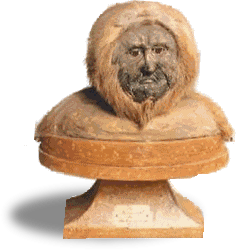 After his next trip to the West Indies, Waterton returned with an animal specimen he labeled "The Nondescript." He claimed it was the preserved remains of a large animal, nearly human. It had furry skin but a human face. Many naturalists of the day were fooled by it. People who saw it were aghast, wondering if the creature Waterton had killed and mounted might have been truly human. It was in fact the skin of a red howler monkey, with an artificial face formed from the animal's backside, and carefully sculpted to look like Agent Lushington.
After his next trip to the West Indies, Waterton returned with an animal specimen he labeled "The Nondescript." He claimed it was the preserved remains of a large animal, nearly human. It had furry skin but a human face. Many naturalists of the day were fooled by it. People who saw it were aghast, wondering if the creature Waterton had killed and mounted might have been truly human. It was in fact the skin of a red howler monkey, with an artificial face formed from the animal's backside, and carefully sculpted to look like Agent Lushington.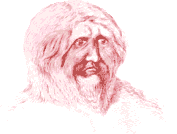 "The Nondescript," from the frontispiece of Waterton's book |
Other creations
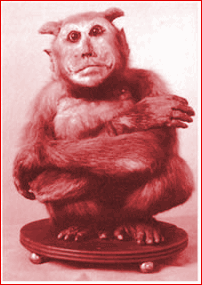 "Martin Luther After His Fall" |
"Noctifer" was made of an owl combined with a long-legged marsh bird, symbolizing (in Waterton's own words) "the Spirit of the Dark Ages, unknown in England before the Reformation." (No one ever claimed he was an expert in history.)
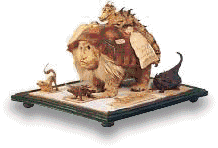 "John Bull and the National Debt" |
What can we learn from this?
I (of all people) can certainly appreciate Waterton's sense of humor, even though I disagree completely with most of the sentiments expressed by his satire. In those days, long before humor began to carry the same social stigma as deliberate cruelty, Waterton's humor was usually appreciated on some level by friends and foes alike. His sense of humor made even an outlandish eccentric like Waterton seem approachable and likable.
As someone who often defends the legitimate use of satire and sarcasm, I want to acknowledge that (while a caricature can often make a valuable point in bold relief) there's a lesson to be learned in the opposite direction, too: If the only thing you have is a stuffed animal made of borrowed parts of this and that, you don't really have much of an argument.
Grotesque taxidermy specimens and comic-book covers are good for illustrative purposes, and the right use of humor can lighten even the most serious discussions. (Here's hoping humor itself will never be totally outlawed by "polite" society.) But caricatures and manufactured monsters are valid only if they substantiate an argument that has elsewhere been made rationally, with true facts, solid logic, and reasonable arguments.
I think we can all agree on that.
Still, if the rational argument has been made, the stuffed monkey can be a very useful illustration or icebreaker. I sometimes wish I had the skill, time, and resources to do taxidermy.
For further study:
- "Charles Waterton," from the Catholic Encyclopedia
- "The Gentle Art of Political Taxidermy: Charles Waterton, Squire of Walton Hall,"
by Sally Shelton, from Annals of Improbable Research - The Charles Waterton Home Page
- Wanderings in South America, a free eBook by Charles Waterton


12 comments:
I sometimes wish I had the skill, time, and resources to do taxidermy.
Well, there's always retirement, right? You could wear one of those white lab coats and look really official. You could preserve Wrigley after he has lived his long and happy doggy life. That should give you about thirteen or so years to hone your new craft.
WHAT?! "anti-Protestant"!?!
By Heavens, Johnson -- you've gone too far this time! To say that Waterton treated Protestants with disdain and bigotry, including the overty statement to obstruct their political rights -- you're gone too far man!
I learned something.
I laughed out loud.
I also hope that there will always be room for good-natured humor. So much "humor" today is just sick.
I wonder what Lushington thought of his likeness?
JRush
When I got to the part about the howler monkey/Agent Lushington, I knew why you HAD to do this post! Fun & informative start on the blogosphere this morning.
"I sometimes wish I had the skill, time, and resources to do taxidermy."
And I am quite certain that some are fervently thankful that you do not.....
An excellent read with a very pertinent message, thank you.
I wonder what it would cost to have a Karl Keating sculpture made out of a monkey backside?
Phrase of the week:
POLEMIC TAXIDERMY
I'm going to put that on my resume:
under leisure interests!!
Keep her lit (Irish phrase for 'keep up the good work') your blog just gets better and better!
Now now, commenters, enough with the fan club appreciation stuff. You all should be much more snippy with Phil, and he should be much nicer to everyone else.
As to the post - my dead-animal-phobic best friend would have a fit if she saw it, but I am digging all the quirky satirical dead things.
Maybe you should start a whole archive of these dead-thing-posts called the evangelical mortuary...
If in England it was the Roman Catholics that were the identifiable eccentrics, does this blog prove that in America it is the fundamentalists?
Russ: No question about it.
Especially if you count the early American Puritans as "fundamentalists." Cotton Mather was probably America's first great eccentric, and many of his spiritual offspring have likewise been more than a little bit odd.
Phil,
Someone with the skill, time, and resources to do taxidermy to the glory of God... ?
Museum
That's very amusing, and illustrative as well.
Yes I would disagree with his beliefs and some of his satirical points, but I'm sure he kept things interesting.
Post a Comment